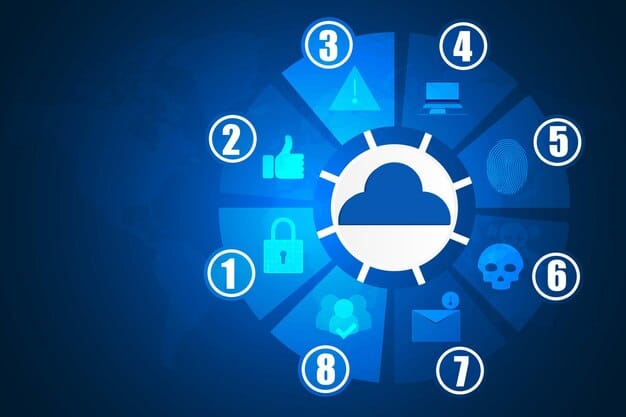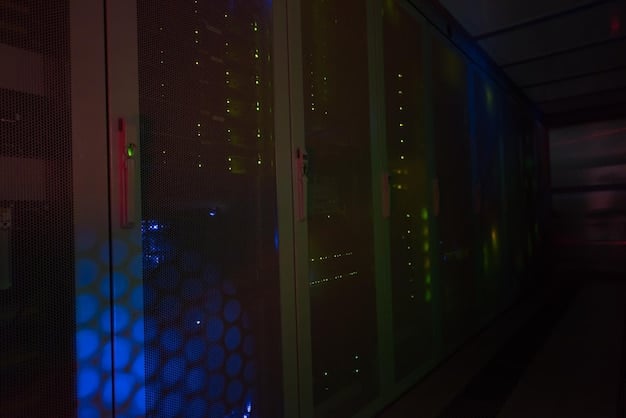Cloud Compliance in the US: Navigating 2025 Regulations

Cloud Compliance in the US: Navigating Regulations in 2025 requires a deep understanding of evolving legal frameworks, including FedRAMP, HIPAA, and GDPR, to ensure data security and operational integrity amidst increasing cyber threats.
Navigating the complex landscape of Cloud Compliance in the US: Navigating Regulations in 2025 demands vigilance and a proactive approach. Understanding the evolving regulations is crucial for safeguarding your data and maintaining customer trust.
Understanding the US Cloud Compliance Landscape
The cloud computing environment in the United States is governed by a complex web of regulations and standards. These regulations aim to ensure data security, privacy, and operational resilience. Staying abreast of these requirements is essential for businesses leveraging cloud services.
Understanding the key players and regulatory bodies involved is the first step towards achieving comprehensive cloud compliance. These entities shape the policies and guidelines that organizations must adhere to.
Key Regulatory Bodies
Several regulatory bodies play a crucial role in shaping cloud compliance in the US. These organizations establish standards and frameworks that businesses must follow to ensure data protection and privacy.
- Federal Trade Commission (FTC): Enforces consumer protection laws and regulates data security practices.
- Department of Health and Human Services (HHS): Oversees HIPAA compliance, ensuring the protection of health information.
- National Institute of Standards and Technology (NIST): Develops standards and guidelines for federal information systems and cybersecurity.

Complying with these regulations requires a multi-faceted approach that incorporates technology, policy, and training. Organizations must implement robust security measures, develop comprehensive compliance programs, and educate their employees on best practices.
Key Cloud Compliance Regulations in the US
Several key regulations govern cloud computing in the US. Each regulation addresses specific aspects of data security, privacy, and operational integrity. Understanding these regulations is critical for businesses using cloud services.
Compliance with these regulations not only ensures legal adherence but also enhances an organization’s reputation, builds customer trust, and fosters a more secure cloud environment.
HIPAA (Health Insurance Portability and Accountability Act)
HIPAA sets the standard for protecting sensitive patient data. Compliance requires implementing administrative, physical, and technical safeguards to ensure the confidentiality, integrity, and availability of protected health information (PHI).
Entities handling PHI in the cloud must enter into Business Associate Agreements (BAAs) with their cloud service providers. These agreements outline the responsibilities of each party in safeguarding PHI.
FedRAMP (Federal Risk and Authorization Management Program)
FedRAMP provides a standardized approach to security assessment, authorization, and continuous monitoring for cloud products and services used by the US federal government. It ensures that cloud solutions meet stringent security requirements.
Achieving FedRAMP authorization can be a rigorous process, requiring significant investment in security controls and documentation. However, it demonstrates a high level of security and reliability, which can also benefit commercial customers.
GDPR (General Data Protection Regulation)
Although GDPR is a European regulation, it affects US companies that process the personal data of EU citizens. Compliance requires obtaining consent for data processing, providing data access and deletion rights, and implementing appropriate security measures.
US companies must ensure that their cloud providers comply with GDPR requirements when processing EU citizens’ data. This may involve implementing data residency solutions and adhering to strict data transfer mechanisms.
In conclusion, navigating the intricate landscape of cloud compliance in the United States demands a nuanced understanding of key regulations such as HIPAA, FedRAMP, and GDPR. By adhering to these standards, organizations can ensure the secure and responsible handling of data, fostering trust and maintaining operational integrity.
Preparing for 2025: Anticipated Regulatory Changes
The regulatory landscape is constantly evolving. Staying ahead of anticipated changes is crucial for maintaining compliance and avoiding potential penalties. Monitoring regulatory updates and engaging with industry experts can help organizations prepare for future requirements.
Predicting regulatory trends involves analyzing emerging technologies, geopolitical developments, and evolving data privacy concerns. By anticipating these trends, organizations can proactively adapt their compliance programs.
Emerging Data Privacy Laws
Several states are considering or have already enacted their own data privacy laws. These laws often mirror elements of GDPR, granting consumers greater control over their personal data. Organizations must be prepared to comply with these diverse state-level regulations.
- California Consumer Privacy Act (CCPA): Grants California residents the right to know what personal information is collected about them, the right to delete their personal information, and the right to opt-out of the sale of their personal information.
- Virginia Consumer Data Protection Act (CDPA): Provides Virginia residents with similar rights to those under CCPA, including the right to access, correct, and delete their personal data.
- Colorado Privacy Act (CPA): Grants Colorado residents the right to access, correct, delete, and port their personal data, as well as the right to opt-out of the processing of their personal data for targeted advertising, sale, or profiling.

Preparing for these regulatory changes requires conducting regular risk assessments, updating privacy policies, and implementing appropriate data security measures. Organizations should also invest in training programs to educate their employees on the requirements of these new laws.
Implementing a Robust Cloud Compliance Program
A robust cloud compliance program is essential for navigating the complex regulatory landscape. Such a program should incorporate policies, procedures, and technologies that ensure adherence to relevant regulations and standards. It should begin with a thorough assessment of the organization’s risk posture.
Creating a culture of compliance within the organization is vital. This involves leadership commitment, employee training, and clear communication of compliance expectations.
Risk Assessment and Management
Conducting regular risk assessments is crucial for identifying vulnerabilities and mitigating potential compliance breaches. These assessments should consider both technical and non-technical risks, such as data breaches, system failures, and employee errors.
Once risks are identified, organizations must implement appropriate mitigation strategies. This may involve implementing security controls, developing incident response plans, and establishing data breach notification procedures.
Data Governance and Security
Effective data governance is essential for maintaining compliance with data privacy regulations. This involves establishing policies and procedures for data collection, storage, use, and disposal. Organizations must also implement robust security measures to protect data from unauthorized access and disclosure.
These security measures may include encryption, access controls, intrusion detection systems, and data loss prevention tools. Regular security audits and penetration testing can help ensure the effectiveness of these controls.
In summary, building a strong compliance program involves proactively assessing risks, adopting strict data governance policies, and fostering a culture of compliance throughout the organization. These steps are essential for navigating the intricate landscape of cloud compliance in the United States.
Tools and Technologies for Cloud Compliance
Several tools and technologies can help organizations achieve and maintain cloud compliance. These tools automate compliance tasks, provide real-time monitoring, and generate compliance reports. Selecting the right tools depends on the organization’s specific needs and compliance requirements.
Leveraging these tools can significantly reduce the burden of cloud compliance, enabling organizations to focus on their core business objectives.
Compliance Automation Platforms
Compliance automation platforms streamline the compliance process by automating tasks such as data collection, evidence gathering, and policy enforcement. These platforms provide a centralized view of compliance status and generate reports for auditors.
These platforms often integrate with various cloud services and security tools, providing comprehensive visibility and control over the organization’s cloud environment.
Security Information and Event Management (SIEM)
SIEM systems collect and analyze security logs from various sources, providing real-time threat detection and incident response capabilities. These systems can help organizations identify and respond to security incidents that could lead to compliance breaches.
SIEM systems also provide valuable insights into the organization’s security posture, enabling them to identify vulnerabilities and improve their security controls.
Cloud Security Posture Management (CSPM)
CSPM tools continuously monitor cloud configurations and identify misconfigurations that could lead to security risks and compliance violations. These tools provide automated remediation recommendations, helping organizations quickly address security issues.
CSPM tools are essential for maintaining a strong security posture in the cloud and ensuring compliance with industry regulations.
Ultimately, adopting the right tools and technologies is crucial for streamlining cloud compliance efforts. By leveraging compliance automation platforms, SIEM systems, and CSPM tools, organizations can proactively manage their security posture and ensure adherence to evolving regulatory requirements.
The Future of Cloud Compliance
The future of cloud compliance will be shaped by emerging technologies such as artificial intelligence (AI) and blockchain. Machine learning can automate compliance tasks, improve threat detection, and enhance risk management. Blockchain can provide a secure and transparent platform for data sharing and compliance auditing.
Preparing for these future trends requires investing in research and development, collaborating with industry partners, and staying informed about emerging regulatory requirements.
AI and Machine Learning in Compliance
AI and machine learning can automate various aspects of cloud compliance, such as data classification, anomaly detection, and security monitoring. These technologies can analyze large volumes of data and identify potential compliance breaches in real-time.
AI-powered tools can also help organizations improve their risk management processes by identifying patterns and predicting future compliance risks.
Blockchain for Secure Data Sharing
Blockchain technology can provide a secure and transparent platform for sharing data with regulators and auditors. Blockchain-based compliance solutions can ensure the integrity and authenticity of compliance data, reducing the risk of fraud and errors.
Blockchain can also enable organizations to streamline their compliance processes by automating data verification and validation tasks.
In conclusion, the future of cloud compliance will be driven by technological advancements such as AI and blockchain. By embracing these innovations, organizations can enhance their compliance processes, reduce risks, and maintain a competitive edge in the evolving cloud landscape.
| Key Point | Brief Description |
|---|---|
| 🛡️ Regulatory Bodies | Understanding FTC, HHS, and NIST roles. |
| 📜 Key Regulations | HIPAA, FedRAMP, and GDPR compliance. |
| 📅 Anticipated Changes | Preparing for emerging data privacy laws. |
| 🤖 Future Trends | AI and blockchain in compliance. |
Frequently Asked Questions
▼
FedRAMP is a US federal government program that standardizes security assessment, authorization, and continuous monitoring for cloud products and services, ensuring they meet high security standards.
▼
US companies processing EU citizen’s data must comply with GDPR, including obtaining consent, providing data access rights, and implementing security measures, regardless of where data is stored.
▼
A robust program includes risk assessments, solid data governance, strong security measures like encryption, access controls, and regular audits, plus a culture of compliance within the organization.
▼
Compliance automation platforms streamline data collection and evidence gathering. SIEM systems offer real-time threat detection, while CSPM tools monitor configurations and recommend fast fixes.
▼
AI automates data classification and security monitoring, offering better threat detection. Blockchain secures data sharing, ensuring compliance data’s authenticity and simplifying verification for data handling.
Conclusion
In conclusion, navigating the intricacies of Cloud Compliance in the US: Navigating Regulations in 2025 requires a multifaceted approach that integrates regulatory knowledge, compliance programs, and technological solutions. Staying informed and proactive is essential for maintaining data security and customer trust.





